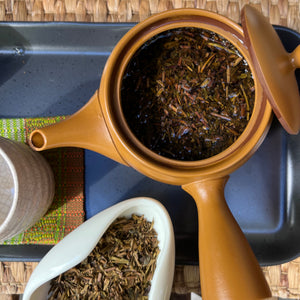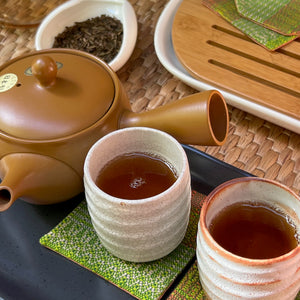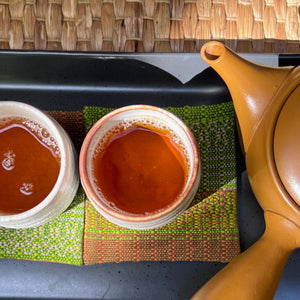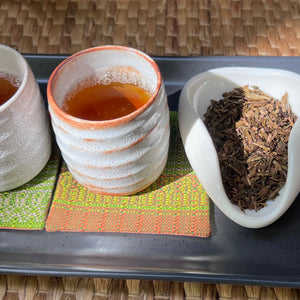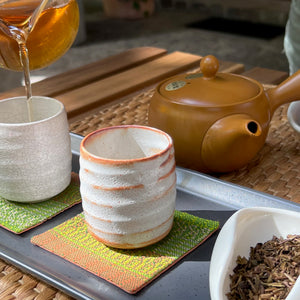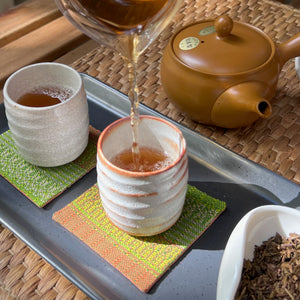
Hojicha Agata no Kaori
Tax included
Shipping calculated at checkout
In stock
Pickup currently unavailable
Agata no Kaori Hōjicha — Shichimeien, Uji • fragrant, roasted until golden brown
Agata no Kaori is Shichimeien's fragrant, golden-brown roasted hōjicha tea: with a distinctly clean, nutty-toasted grain character, little bitterness and a smooth sip. A soothing, warm, "homey" cup for everyday tea drinking.
Origin & style
- Region: Uji, Kyoto — the historical center of Japanese tea culture.
- Creator: Horii Shichimeien (founded 1879).
- Style: medium roasted hōjicha , strong aroma, low bitterness.
Processing in brief
Carefully selecting leaves suitable for Hōjicha, roasting them evenly to a golden brown; the goal is to enhance the aroma and maintain a clean, smooth taste.
Flavor profile
- Aroma: toasted grain, nuts, hazelnuts, delicate caramel.
- Taste: round and clean; nutty-malty tones, faint brown sugar and roasted sesame seeds.
- Finish: soft, warm, with a slight bitterness.
Recommended preparation
Japanese (kyusu) method
- 5–6 g / 200 ml soft water
- 90–95°C
- 1st pour: 45–60 sec • 2nd: 20–30 sec • 3rd: 45–60 sec
Western method
- 3g / 250–300ml
- 90–95 °C, 2–3 minutes
- Second pour: +30–45 sec.
Cold brew / cold soak
- 8–10 g / 1 liter
- Refrigerate for 6–8 hours
- Result: a silky, clean and refreshingly nutty-roasted cup.
Things to know
- Packaging (manufacturer's): 100 g and 200 g (guideline).
- Preparation guidelines (manufacturer's): "For 2 people" approx. 12 g / serving.
- Shelf life (manufacturers): ~6 months from date of manufacture.
Difference between versions
Shichimeien Ujichashi Hōji tea is described by the manufacturer as having a “cleaner taste” and more fragrant than Agata no Kaori — Agata no Kaori has a rounder, “gentler” everyday profile.
Note: The proportions are starting points; you may want to fine-tune them according to water, equipment, and taste.

Personal contact
Our teas don't come from wholesale warehouses or unknown sources. We travel to the small producers we source from – whether it's a Japanese family tea garden, a Chinese mountain village or an oolong maker in Taiwan.
Stories
We meet them in person, learn their story, see how they care for their plants, and how they process the fresh leaves.
These experiences are the soul of our teas. This way, not only is the quality guaranteed, but also the fact that behind each cup there is a real person, a real story.


Direct
This direct relationship is valuable to us. Not only because of the excellent tea, but because we believe that trust, respect and personal presence are what make the tea drinking experience truly special.
Teavolution Tea Blog
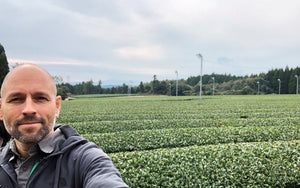
Oct 2, 2025
Sencha tea
Read more

Sep 21, 2025
Matcha hiány Japánban
Read more
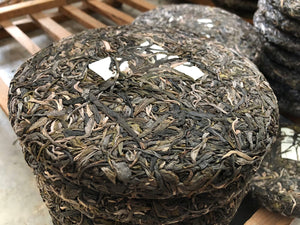
Mar 18, 2025
Puer tea, puerh or pu-erh
Read more
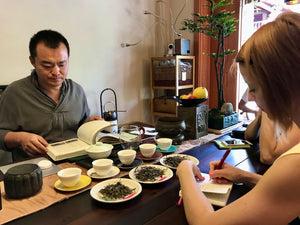
Mar 18, 2025
Types of tea
Read more
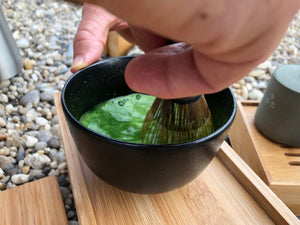
Mar 18, 2025
What is matcha tea?
Read more

Mar 18, 2025
Oolong tea (Wulong tea)
Read more

